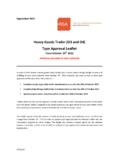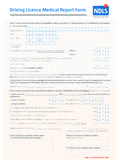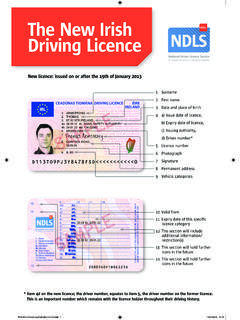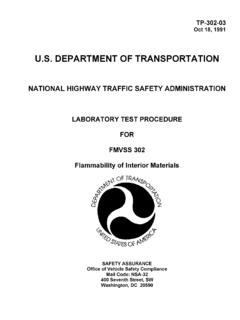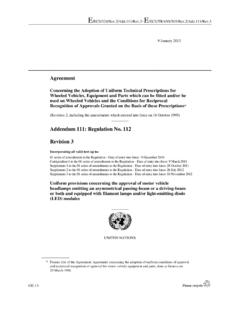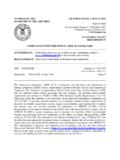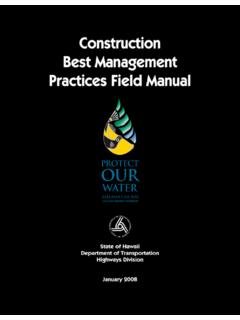Transcription of Euro IV, Euro V and VI Emissions Regulations for …
1 1 September 2016 Euro IV, Euro V and VI Emissions Regulations for heavy Duty vehicle Information Note Introduction As a member of the European Union, Ireland is obliged to introduce Directive 2005/55/EC (and its amendments1) and EC Regulation 595/2009 (as amended2) referred to as the heavy duty Euro Emissions Regulations . The heavy duty emission Regulations apply to new passenger and goods vehicles of categories of M and N with a reference mass3 in excess of 2,610kg. These Regulations lay down limit values for Emissions of gaseous and particulate pollutants and for the opacity of exhaust fumes from diesel, natural gas and liquefied petroleum gas (LPG) engines. Euro IV heavy duty Emissions Regulations have applied to new vehicles registered in the State since 1/10/2006 and were replaced by Euro V Regulations which have applied to new vehicles registered since 1/10/2009. The major difference between the Euro IV and Euro V is the reduction in the emission limits for nitrogen oxides from to g/kWh.
2 The Euro VI heavy duty emission Regulation sets tougher emission limits than Euro V and lowers limits of several pollutants (CO, THC, NMHC, CH4, NOX, NH3), adopts the worldwide harmonised drive cycles, revises the durability requirements to cover greater distances and include measures relating to access to vehicle repair and maintenance information. 1 implementing Directive 2005/78/EC as amended by 2006/51/EC and 2008/74/EC 2 by EC Regulation 582/2011 3 Reference mass means the mass of the vehicle in running order less the uniform mass of the driver of 75kg and increased by a uniform mass of 100kg (refer to Certificate of Conformity point ) 2 September 2016 Vehicles equipped with Euro V engines must be registered by 30th December 2013 and vehicles registered after this date must be Euro VI compliant. In certain conditions, an end of series exemption can be applied for, which if granted, will allow vehicles an extended period of time for registration.
3 Further information on the criteria for applying for an end of series exemption and details as to how you should apply, can be found on our end of series webpage. More detailed implementation dates for each vehicle category are summarised at the end of this document. Objectives of the heavy duty Euro Emissions Regulations Improving the health and welfare of the European population is an important objective for the EU authorities. Euro IV, V and VI heavy duty vehicle Emissions Regulations set the Emissions limits for motor vehicles and their specific objectives are as follows; To set harmonised rules on the construction of motor vehicles. The proper functioning of the single market in the European Union requires common standards limiting the emission of atmospheric pollutants from motor vehicles. Action at Community level prevents varying product standards emerging across Member States which results in fragmentation of the internal market and imposition of unnecessary barriers to intra-Community trade.
4 Also through harmonised standards it is possible to reap the economies of scale as production series can be made for the whole European market. To improve air quality by reducing pollutants emitted from the road transport sector by setting the emission limit values for all vehicle categories with a reference mass in excess of 2,610kg4. Member States and their citizens are concerned about the impacts of air pollution on human health and the environment. Although air quality has improved over the past decade, there are still significant air quality problems throughout the European Union, especially in urban areas and in densely populated regions. To introduce measures relating to access to vehicle repair and maintenance information. Easy and clear access to information on vehicle repair and maintenance is key to guaranteeing free competition on the vehicle aftermarket.
5 To this end, manufacturers must ensure that independent operators active on the vehicle aftermarket have easy, restriction-free and standardised access to information on the repair and maintenance of vehicles, without discrimination with respect to authorised dealers and repair workshops. 4 Reference mass means the mass of the vehicle in running order less the uniform mass of the driver of 75kg and increased by a uniform mass of 100kg (refer to Certificate of Conformity point ) 3 September 2016 Background The Regulations were originally introduced by the Directive 88/77/EEC and have since been subjected to a number of amendments. Given developments in automotive technology, increased demand for road transport and continuing air quality problems, there has been a need to keep standards under review. In 2005, the Directives were re-cast and consolidated by the Directive 2005/55/EC.
6 In 2009, in order to simplify legislation, EC Regulation 595/2009 was introduced repealing and replacing EC Directives 2005/55/EC and 2005/78/EC. The use of an EC Regulation ensures that the technical provisions are directly applicable to manufacturers, approval authorities and technical services and they can be updated in a fast and efficient way. Directive 2005/55/EC introduced durability and On Board Diagnostic (OBD) requirements and set the emission limits for Euro IV and Euro V. In a split-level regulatory approach, the technical requirements pertaining to durability and OBD, including provisions for emission systems that use consumable reagents, have been prescribed in Directive 2005/78/EC. Regulation 595/2009 as amended by Regulation 582/2011 introduced the new Euro VI heavy duty emission limits, the measuring of carbon dioxide (CO2) Emissions , the establishment of numerical limits on particulate Emissions , worldwide harmonised drive cycles, revised the durability requirements, access to vehicle repair and maintenance information and incorporates all of the requirements on engine power from EC Directive 80/1269/EEC as amended by 1999/99/EC.
7 The technical requirements of these regulatory acts took effect in three stages, Euro IV emission limits came into effect for new type approvals from 1st October 2005 (and new registrations from 1st October 2006), Euro V emission limits applied from 1st October 2008 for new type approvals (and new registrations from 1st October 2009) and Euro VI Emissions for new type approvals will apply from 31st December 2012 (and new registrations from 31st December 2013). 4 September 2016 Implications for Irish stakeholders Although there is no indigenous engine manufacturing industry in Ireland, the introduction of the tighter Euro IV, V and VI emission limits will have implications at vehicle registration for a number of sectors such as importers, distributors and converters of commercial vehicles. From the mandatory dates of registration, new vehicles are required to be accompanied by type approval certification to the appropriate levels of Euro Emissions standards.
8 There are obligations on vehicle operators and owners to maintain the parts and equipment of their vehicles in good and efficient working order and this includes the Emissions control devices and after-treatment systems. Tampering with systems which control the level of Emissions , or driving a vehicle without consumable reagent (vehicles fitted with an after-treatment system) is prohibited. The introduction of the Directives and Regulations will help to ensure the proper functioning of the internal EU market and will guarantee a common level of Emissions amongst all vehicles within Europe. They will also facilitate an improvement in air quality, which in turn will improve public health, thus enabling the Government to generate savings in the longer term. Requirements of Regulation 595/2009 as amended by 582/2011 Euro VI Emissions Limits The Euro VI Regulations introduce a reduction of 77% in the limit for nitrogen oxides (NOx) and 50% for particulate matter (PM) Emissions compared to the Euro V stage limits which entered into force in October 2008.
9 (Further information on the limits can be accessed in Annex 1 of Regulation 595/2009). Consumable Reagent (AdBlue) The heavy duty Emissions Regulations set requirements with regard to the fitment of an after-treatment system in order to establish standards for pollutant Emissions . The current Regulations place an obligation on member states to ensure that manufactures, repairers and operators do not tamper with the after-treatment system. Operators of the vehicles are obliged to ensure that the vehicle must not be driven without a consumable reagent. Penalties for breach of these requirements are set out in the paragraph on penalties that follows. 5 September 2016 CO2 Emissions Carbon dioxide (CO2) must be calculated during the Emissions tests however no limits on CO2 Emissions are specified. Access to vehicle Repair and Maintenance Information Requirements are introduced to ensure that vehicle manufacturers make information related to their on-board diagnostic systems readily available to independent vehicle repairers.
10 These new requirements are based on those already included in the light duty vehicle Euro5/6 Emissions Regulation, (EC) 715/2007. Penalties for breach of these Regulations Penalties for breach of type approval entry into service requirements SI 448 of 2007 European Communities (Mechanically Propelled vehicle Entry Into service) Regulations 2007 (as last amended by No. 234 of 2011) requires that new vehicles being presented for first registration to meet with the construction, technical and performance requirements specified in EU type approval directives and Regulations , and are accompanied by appropriate certificates of conformity. These Regulations mandate that vehicles presented for registration have certificates of conformity to the heavy duty emission Regulations referred to in this document from the appropriate dates. A person guilty of an offence under these Regulations is liable on summary conviction to a fine not exceeding 5,000.

